NCERT Class 10 Solutions Chapter 13: Magnetic Effects of Electric CurrentThis article provides the most elaborated and explained answers to NCERT questions of class 10 science chapter 13. Here you will be able to find the solutions of class 10 science chapter 13, magnetic effects of electric current. These solutions will be very helpful for candidates looking for instant elaborated solutions to NCERT questions. Students who will be appearing for class 10 board exams will also get a huge benefit from these solutions. 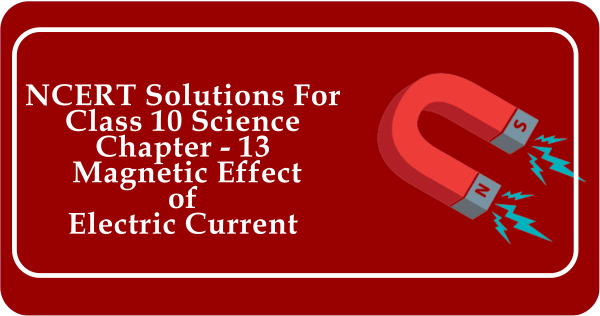
Learn everything there is to know about the Magnetic Effects of Electric Current. NCERT Solutions can be helpful in many ways, like it will help you to get instant answers. These answers are properly researched and written so students can make the most of them. Moreover, you will also find explanatory parts, which will help students cover the theory and revision. Apart from it, this will also help students finish their homework early so they can get more time for self-study. NCERT Solutions for Class 10 Science Chapter 13 Inside Book QuestionsPage Number: 224Question 1: Why does a compass needle get deflected when brought near a bar magnet? Answer: The magnet's magnetic field pulls the compass needle's two poles apart. The two poles are subject to equal and opposing forces. The combination of these two forces deflects the compass needle. To understand how the magnetic force is distributed around and inside magnetic objects in nature, we utilize the concept of a magnetic field. The area around a magnet where magnetism can exert its influence is known as the magnetic field. When the bar magnet's magnetic field intercepts the compass needle's magnetic field, the compass needle deflects because it encounters a distinct magnetic field, which causes the needle to travel in one of two directions - attraction or repulsion. Page Number: 228Question 1: Draw magnetic field lines around a bar magnet. Answer: 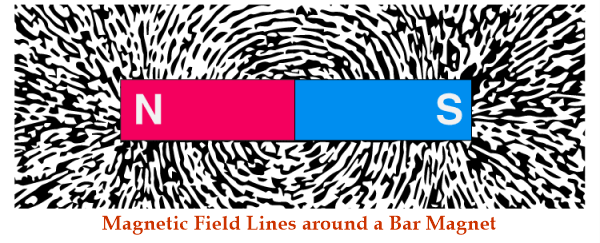
Bar Magnets and Magnetic Field Lines: 1.) Magnetic Field Lines - Magnetic field lines are those in a magnetic field whose density determines the field's magnitude and whose density, at any given location, shows the direction of the field. 2.) Bar Magnet - A bar magnet is a rectangular piece of steel, iron, or any other ferromagnetic material or ferromagnetic composite having persistent magnetic properties. Magnetic Fields Lines around a bar magnet:
Question 2: List the properties of magnetic lines of force. Answer: Properties of magnetic lines of force : Magnetostatics
Magnetic Field Lines
Question 3: Why don't two magnetic lines of force intersect each other? Answer: Because the force acting on a north pole at any given location may only be directed in one direction, two magnetic lines of force do not meet. If the two magnetic field lines were to connect, the resultant force on the north pole at the intersection point would be in two directions, which is not practical. The tangential component of the curved lines, known as magnetic lines of force, is used to characterize the direction of the magnetic field. The lines that describe the magnetic field pattern are hypothetical; they do not truly exist. South to the north is the direction of the imaginary magnetic field lines inside and outside of the magnet, respectively. Because it would be impossible for the compass needle to point in two different directions if the two magnetic field lines intersect, they do not. Therefore, magnetic lines do not cross one other. Page Number: 229 - 230Question 1: Consider a circular loop of wire lying on the plane of the table. Let the current pass through the loop clockwise. Apply the right hand rule to find out the direction of the magnetic field inside and outside the loop. Answer: 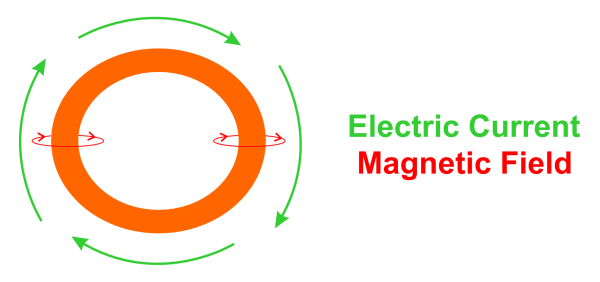
As seen in the figure above, each length of wire generates a unique circular arrangement of lines of force. According to the right-hand thumb rule, we find that all the sections produce a magnetic field directed downward at all places inside the loop and upward at all points outside. Because of this, the magnetic field behaves ordinarily outside the loop, acting out of the paper's plane and appropriately inside the loop, acting into the plane. Question 2: The magnetic field in a given region is uniform. Draw a diagram to represent it. Answer: 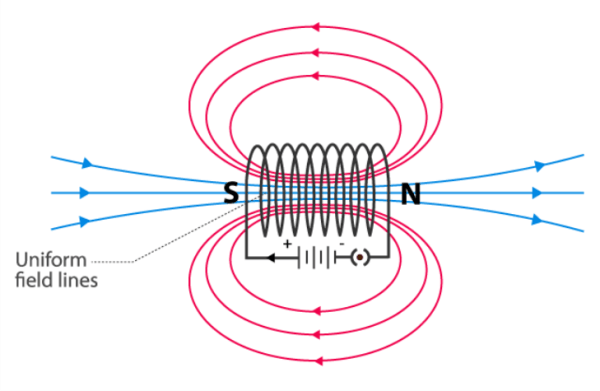
In order to portray a region's uniform magnetic field, parallel, straight lines must all point in the same direction. For instance, parallel straight lines pointing from a current-carrying solenoid's S-pole to its N-pole can represent the solenoid's uniform magnetic field (as shown in the figure). Question 3: Choose the correct option. The magnetic field inside a long straight solenoid-carrying current
Answer: iv.) Is the same at all points. Explanation for the Correct Option:

Where, B is the magnetic field. N is the number of turns in the solenoid. I is the current in the coil. L is the length of the coil.
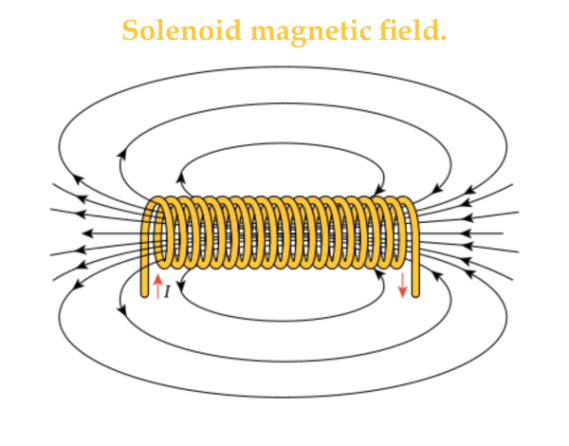
Explanation for the Incorrect Option: Option (i): It is commonly accepted that the magnetic field is constant throughout a magnetic field, not zero inside a long straight solenoid-carrying current. As a result, the concept that is presented is false. Option (ii): As we approach the end of a long straight solenoid, its magnetic field neither increases nor decreases. Instead, it is claimed to be constant across a magnetic field. As a result, the suggested solution does not match the right idea. Option (iii): As we approach the end of a long, straight solenoid, its magnetic field neither grows nor decreases. Instead, it is claimed to be constant across a magnetic field. As a result, the suggested solution does not represent the right idea. Therefore, choice (iv) is the appropriate answer. Page Number: 231 - 232Question 1: Which of the following property of a proton can change while it moves freely in a magnetic field. (There may be more than one correct answer.)
Answer: The correct options are (iii) velocity, (iv) momentum. Explanation:
Hence, Options (iii) and (iv) are correct. Question 2: In Activity 13.7 how do we think the displacement of rod AB will be affected if
Answer: A current-carrying wire experiences a force when it is fixed in the magnetic field. This force is proportional to the wire's length, the magnetic field's intensity, and the current flowing through it. Therefore, when a stronger horseshoe magnet is used, the magnetic field's strength is high, causing it to experience a bigger force and, as a result, to be more displaced. The following factors will have an impact on how far the rod AB moves:
Question 3: A positively-charged particle (alpha particle) projected towards west is deflected towards north by a magnetic field. The direction of magnetic field is :
Answer: The correct option is Option (iv) upward Explanation: By Fleming Left-Hand Rule - According to the Fleming left-hand rule, the thumb will represent the direction of the force if we stretch our thumb, forefinger, and middle finger of our left-hand perpendicular to each other in such a way that the forefinger points in the direction of the magnetic field and the middle finger points in the direction of the current. Explanation for the Correct Option (iv)
As a result, Option (iv) is the right answer. Page Number: 233Question 1: State Fleming's left hand rule. Answer: 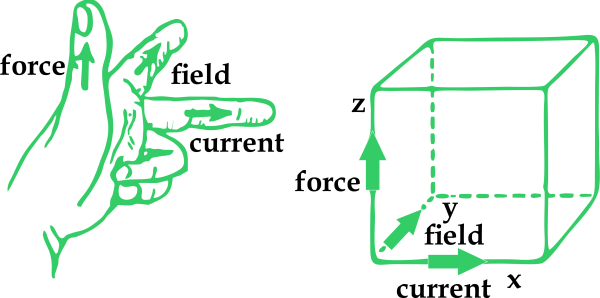
Fleming's Left Hand Rule: Stretch the index finger, the middle finger, and the thumb of your left hand mutually perpendicular to each other in such a way that the index finger represents the direction of the magnetic field, the middle finger represents the direction of the current in the conductor, then the thumb will represent the direction of motion of the conductor. The electric current, magnetic field, and force directions are similar to three mutually perpendicular axes, i.e., x, y, and z-axes. Question 2: What is the principle of an electric motor? Answer: 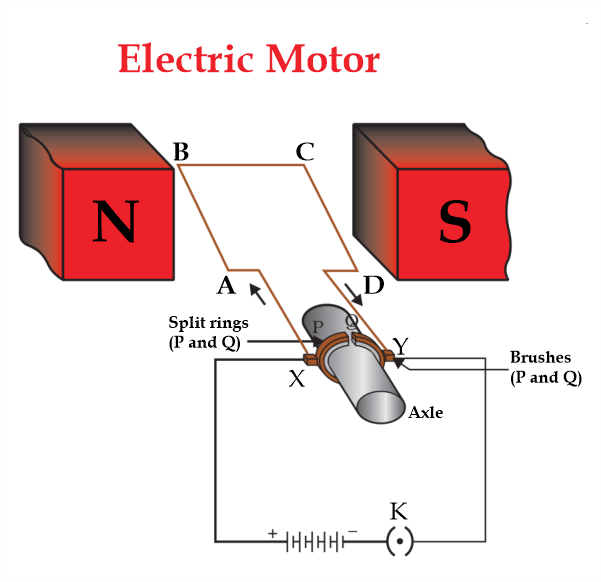
A motor operates on the Principle of current's magnetic effect. A force acts on a rectangular coil to cause it to rotate constantly when current is supplied through it while it is in a magnetic field. The shaft that is connected to the coil also rotates. This process turns the electrical energy that is delivered to the motor into the mechanical energy needed for rotation. Electric motor: A device that transforms electrical energy into mechanical energy is an electric motor. A DC motor operates on the tenet that an electric current flows via a conductor that is generally positioned in a magnetic field. The conductor is subjected to a force, which causes the conductor to start moving and produce mechanical energy. Question 3: What is the role of the split ring in an electric motor? Answer: After every half-rotation, the split ring serves as a commutator, reversing the current direction in the armature coil. After every half circle, the reversed current changes the direction of the forces acting on the two armature arms. As a result, the armature coil can continue to revolve in the same direction. 1.) Split ring: Even though it is made up of a simple circular as well as a cylindrical shell that would be separated axially with the parts isolated from one another, the split ring in an electric motor is classified as a commutator. 2.) Split ring's function in an electric motor: The current trajectory through the coil is reversed by using the split ring. The current inside the coil must always be reversed for the coil to rotate in almost the same or the same direction indefinitely. As a result, after every half-circle, the direction in which such a pair turns the coil continues to be consistent, and the coil continues to move in the same manner. Page Number: 236Question 1: Explain different ways to induce current in a coil. Answer: Various methods for creating a current in a coil
Page Number: 237Question 1: State the principle of an electric generator. Answer: The electric generator operates on the Principle that current is induced in a straight conductor when it is moved in a magnetic field. A rectangular coil is forced to rotate quickly in the magnetic field created between the poles of a horseshoe-shaped magnet in an electric generator. A current is generated in the coil as a result of the magnetic field lines being cut while the coil rotates. 1.) Electric Generator: 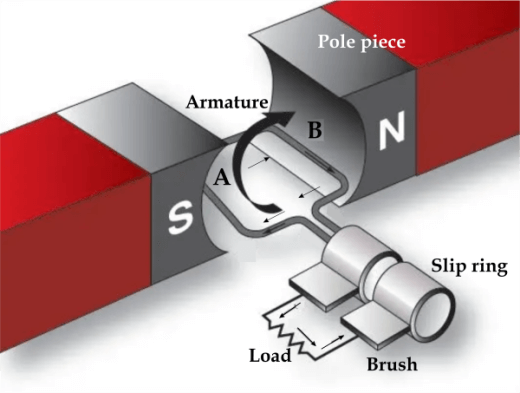
Electric Generator: A device that transforms mechanical energy into electrical energy is an electric generator. 2.) Electromagnetic Induction: 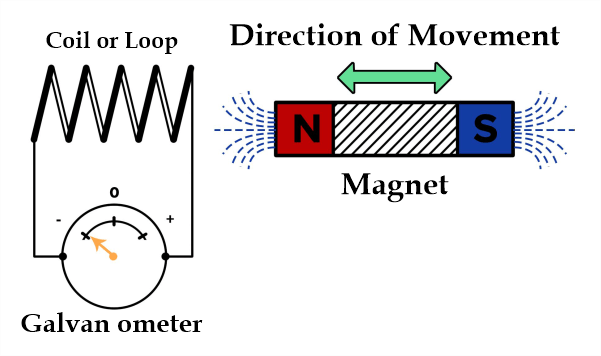
Electromagnetic Induction: It is a process in which, a conductor is placed in a certain location while the magnetic field around it changes. 3.) Principle of an Electric Generator: It operates according to the electromagnetic induction principle, which states that when a straight conductor moves in a magnetic field, the conductor really contains the current. 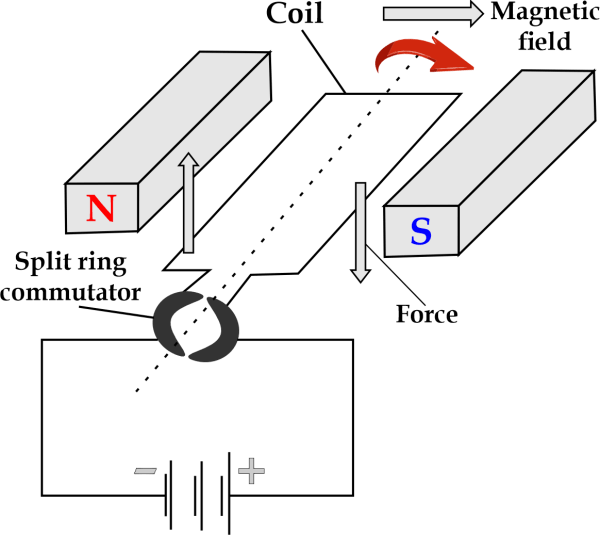
In the diagram below, a horseshoe-shaped magnet's poles are used to create a magnetic field that causes a rectangular coil to revolve quickly. The magnetic field lines are cut as the coil turns, causing the coil to create electricity. Question 2: Name some sources of direct current. Answer: Direct current:
Sources of direct current:
So a battery is the typical direct current (DC) source. Question 3: Which sources produce alternating current ? Answer: Alternating Current:
Source of alternating current: AC generators:
Power Plants:
Question 4: Choose the correct option : A rectangular coil of copper wires is rotated in a magnetic field. The direction of the induced current changes once in each:
Answer: iii.) Half revolution Explanation: Option (iii) Half revolution is the right answer.
As a result, Option (iv) is right. Page Number: 238Question 1: Name two safety measures commonly used in electric circuits and appliances. Answer: Two safety measures commonly used in electric circuits and appliances are: 1.) Electric Fuse: A series connection is made to an electric fuse. It guards against overloading and stops short-circuiting the circuit.
2.) Proper Earthing: An electrical circuit that is properly earthed prevents shocks from occurring by transferring any current leaks from electric appliances to the ground.
Therefore, two safety precautions frequently utilized in electrical circuits and appliances are Electric Fuse and Proper Earthing. Question 2: An electric oven of 2 kW power rating is operated in a domestic electric circuit (220 V) that has a current rating of 5 A. What result do you expect? Explain. Answer: The electric oven draws a current given by, 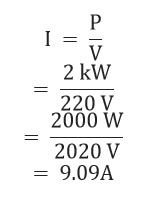
As a result, the electric oven uses far more current than the 5 A current rating allows. The circuit is overloaded as a result. The fuse wire will blow, and the circuit will short out due to an excessive current. Question 3: What precautions should be taken to avoid the overloading of domestic electric circuits? Answer: The following measures should be taken to prevent household electric circuits from becoming overloaded:
NCERT Solutions for Class 10 Science Chapter 13 Textbook Exercise QuestionsQuestion 1: Which of the following correctly describes the magnetic field near a long straight wire?
Answer: iv.) The field consists of concentric circles centred on the wire Explanation: Magnetic field:
Magnetic field lines of a long straight wire:
Therefore, Option (iv) is correct based on the information provided above on the magnetic field lines of a long straight wire. Question 2: The phenomenon of electromagnetic induction is
Answer: iii.) Producing induced current in a coil due to relative motion between a magnet and the coil Explanation: Electromagnetic induction:
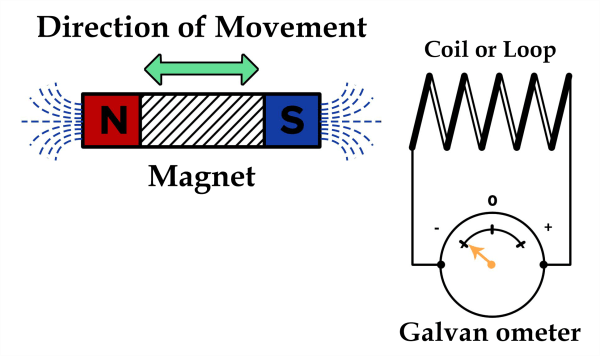
Hence, Option(iii) is correct. Question 3: The device used for producing electric current is called a
Answer: i.) Generator Explanation: Electric motors employ electric current to perform mechanical work, while electric generators are devices used to create an electric current. A galvanometer can detect the current in a circuit, and an ammeter can quantify that current. Question 4: The essential difference between an AC generator and a DC generator is that
Answer: iv.) AC generator has slip rings while the DC generator has a commutator Explanation: The justification for the right answer Option (iv).
As a result, Option (iv) is right. The justification for the incorrect answer(s): Option (i) DC generator has a permanent magnet, whereas an AC generator has an electromagnet. 1.) In both AC and DC generators, the coil is positioned between two permanent magnets with opposing polarity facing one another. As a result, Option (i) is incorrect. Option (ii) The DC generator will produce more voltage. 1.) Low voltages are created using DC generators. As a result, Option (ii) is incorrect. Option (iii) The AC generator will provide more voltage. 1.) AC generators indeed produce high voltage. This does not, however, differentiate between AC and DC generators. As a result, Option (iii) is incorrect. Thus, Option (iv) is the right answer. Question 5: At the time of short circuit, the current in the circuit
Answer: iii.) Increases heavily. Explanation:
Hence Option (iii) is the correct option. Question 6: State whether the following statements are True or False.
Answer:
Question 7: List three sources of magnetic fields. Answer: Three source of Magnetic fields are Permanent Magnet
Electromagnet
Current carrying Conductor
Question 8: How does a solenoid behave like a magnet ? Can you determine the north and south poles of a current-carrying solenoid with the help of a bar magnet? Explain. Answer: A solenoid is a coil of several circular turns of tightly wound insulated copper wire in the form of a cylinder. The solenoid acts in the following ways like a magnet: -
By placing a magnet's north pole close to either end of the solenoid, we can identify the north and south poles of the device. The magnet is unlike the south pole if it is attracted and like the north pole if it is repelled. Question 9: When is the force experienced by a current-carrying conductor placed in a magnetic field largest? Answer: Conductor for carrying current: current-carrying conductor is exposed to a magnetic field.These factors determine the use of such force:
The strength of the force acting on the conductor is greatest or highest when the direction of the electric current and the external magnetic field are perpendicular to one another. Question 10: Imagine that you are sitting in a chamber with your back to one wall. An electron beam, moving horizontally from back wall towards the front wall, is deflected by a strong magnetic field to your right side. What is the direction of magnetic field? Answer: The current will flow in the opposite direction, from the front wall to the rear wall or towards us, because the electron beam is traveling from our back wall to the front wall in this instance. The force is coming from our right side in the direction of deflection. Two things are now clear to us:
Let's now hold our left hand's forefinger, middle finger, and thumb at a 90-degree angle to one another. Now, we position the hand so that the thumb faces the right side and the middle finger points in the direction of the stream (in the direction of force). Our fingertip will now be pointing vertically downward if we look at it. The magnetic field is vertically downward because the direction of the fingers indicates the direction of the magnetic field. Question 11: Draw a labelled diagram of an electric motor. Explain its principle and working. What is the function of a split ring in an electric motor? Answer: 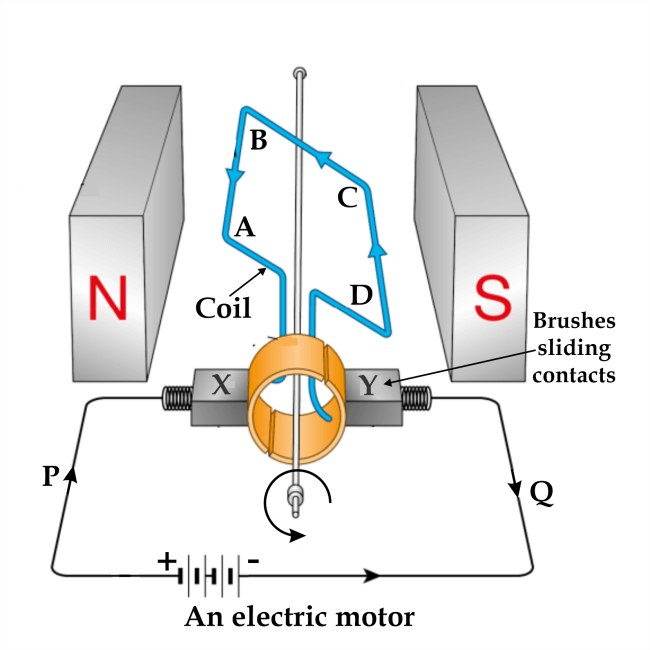
Electric Motor: Electric motors are the tools used to transform electrical energy into mechanical energy. It is utilized in machinery like fans. Principle: The principle of an electric motor is based on the force that a conductor is carrying current encounters in a magnetic field. The two opposing forces are equal and complementary. They cause rotational motion because they operate along distinct lines. Working of an Electric Motor: The coil ABCD is horizontal when the current begins to flow. The armature coil's current flows in two directions: from A to B in arm AB and from C to D in arm CD. The Fleming left-hand law can determine the direction of the force acting on the coil. This law reveals that the coil is pushed downward by force applied to component AB. While the portion CD is being pushed upward by force applied to it. This way, these two forces, which are equal and in opposition to one another, combine by rotating the coil counterclockwise. The current in the coil is halted when the coil is vertical because the brushes X and Y would come into contact with the commutator's center. Even if the current is cut off, momentum causes the coil to return to its horizontal position. The polarity of the commutator also changes after half a revolution because Q now contacts brush X, and P contacts brush Y. As a result, the force now acts downwardly on arm AB and upwardly on arm CD, and once more, a couple of forces are created that cause the coil to revolve in a clockwise orientation. The coil rotates because this process is performed over and over until current starts flowing through it. The Function of Split Ring : The split ring of a motor serves as a commutator, which means that reversing the circuit's current flow also changes the direction of the forces acting on the arms. Question 12: Name some devices in which electric motors are used. Answer: An electric motor is a device that transforms electrical energy into mechanical energy. Water pumps, fans, mixers, and washing machines all employ electric motors. Question 13: A coil of insulated copper wire is connected to a galvanometer. What will happen if a bar magnet is (i) pushed into the coil, (ii) withdrawn from inside the coil, (iii) held stationary inside the coil? Answer: First let us understand Galvanometer.
i.) When Bar Manet is Pushed into the Coil A transient deflection in the galvanometer is seen as a bar magnet is pushed into the coil, indicating the generation of a momentary current in the coil. ii.) When Bar Manet is Withdrawn from Inside the Coil The galvanometer deflects in the opposite direction when the bar magnet is removed from the coil, indicating the development of an opposing current. iii.) When Bar Manet is Held stationary Inside the Coil There is no deflection in the galvanometer while the bar magnet is kept stationary inside the coil, suggesting no current is generated. Question 14: Two circular coils A and B are placed closed to each other. If the current in the coil A is changed, will some current be induced in the coil B? Give reason. Answer: YES! Two circular coils, A and B, will induce some current in coil B when they are put close to one another, and the current in coil A is altered. The magnetic field around coil B also varies due to the magnetic field associated with coil A. Coil B experiences an electric current due to the shift in the magnetic field lines surrounding it. Electromagnetic induction is the term for this process. Question 15: State the rule to determine the direction of a (i) magnetic field produced around a straight conductor-carrying current (ii) force experienced by a current-carrying straight conductor placed in a magnetic field which is perpendicular to it, and (iii) current induced in a coil due to its rotation in a magnetic field. Answer: i.) Rule to determine the direction of a magnetic field produced around a straight conductor-carrying current is Right Hand Thumb Rule. Right Hand Thumb Rule: The direction of the curl of the fingers will reveal the direction of the magnetic field if the current-carrying conductor is held in the right hand with the thumb pointing in the direction of the current. ii.) Rule to determine the direction of a force experienced by a current-carrying straight conductor placed in a magnetic field which is perpendicular to it is Fleming's Left Hand Rule. Fleming's Left Hand Rule: Stretch the left hand's thumb, middle finger, and forefinger, so they are all perpendicular to one another. The thumb will point in the direction of the force in the conductor if the forefinger points in the direction of the magnetic field and the middle finger in the direction of the current. iii.) Rule to determine the direction of a current induced in a coil due to its rotation in a magnetic field is Fleming's Right Hand Rule. Fleming's Right Hand Rule: Stretch the right hand's thumb, forefinger, and middle finger mutually perpendicular to each other. If the forefinger points in the direction of the magnetic field, the thumb in the direction of motion of the conductor, then the middle finger points in the direction of current induced in the conductor. Question 16: Explain the underlying principle and working of an electric generator by drawing a labelled diagram. What is the function of brushes? Answer: 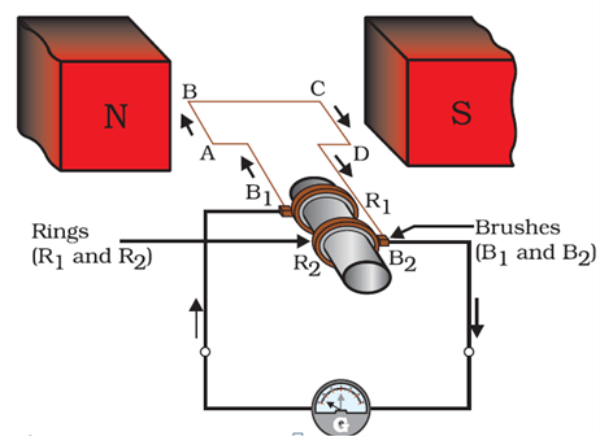
Principle: The electromagnetic induction theory serves as the principle for the electric generator. A coil's number of magnetic field lines changes when it is turned about a magnetic field. This causes a current to be produced in the coil, and Fleming's right-hand rule can be used to determine its direction. Working: The magnetic lines of force are cut through as the armature coil ABCD rotates in a magnetic field created by the permanent magnets. The armature coil's spinning generates an induced electromagnetic force in the corresponding magnetic field. With Fleming's right-hand rule, it is possible to establish the direction of this produced electromotive force or current. As a result, the current generated is alternating. Brush B1 moves the current in one direction during the first half of the cycle, while brush B2 moves it in the other way during the second. This procedure keeps going. Functions of Brushes: The current for exterior usage is provided by brushes in contact with rings. Question 17: When does an electric short circuit occur? Answer: If the circuit's wires' insulation is compromised or the appliance is defective, causing the live wire and neutral wire to come into direct contact, the circuit's current will increase, and a short circuit will follow. Question 18: What is the function of an earth wire? Why is it necessary to earth metallic appliances? Answer: Function of an earth wire are:
Its significance for metallic appliances on earth:
The earth wire is a special wire with low resistance and a high melting point which prevent live wire overloading and current leakage through the ground.
Next TopicClass 10 Science Chapter 14
|
 For Videos Join Our Youtube Channel: Join Now
For Videos Join Our Youtube Channel: Join Now
Feedback
- Send your Feedback to [email protected]
Help Others, Please Share










